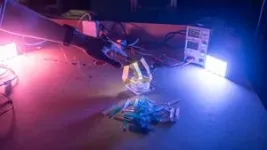(Press-News.org) Robotics researchers have already made great strides in developing sensors that can perceive changes in position, pressure, and temperature – all of which are important for technologies like wearable devices and human-robot interfaces. But a hallmark of human perception is the ability to sense multiple stimuli at once, and this is something that robotics has struggled to achieve.
Now, Jamie Paik and colleagues in the Reconfigurable Robotics Lab (RRL) in EPFL’s School of Engineering have developed a sensor that can perceive combinations of bending, stretching, compression, and temperature changes, all using a robust system that boils down to a simple concept: color.
Dubbed ChromoSense, the RRL’s technology relies on a translucent rubber cylinder containing three sections dyed red, green, and blue. An LED at the top of the device sends light through its core, and changes in the light’s path through the colors as the device is bent or stretched are picked up by a miniaturized spectral meter at the bottom.
“Imagine you are drinking three different flavors of slushie through three different straws at once: the proportion of each flavor you get changes if you bend or twist the straws. This is the same principle that ChromoSense uses: it perceives changes in light traveling through the colored sections as the geometry of those sections deforms," says Paik.
A thermosensitive section of the device also allows it to detect temperature changes, using a special dye – similar to that in color-changing t-shirts or mood rings – that desaturates in color when it is heated. The research has been published in Nature Communications and selected for the Editor's Highlights page.
A more streamlined approach to wearables
Paik explains that while robotic technologies that rely on cameras or multiple sensing elements are effective, they can make wearable devices heavier and more cumbersome, in addition to requiring more data processing.
“For soft robots to serve us better in our daily lives, they need to be able to sense what we are doing,” she says. “Traditionally, the fastest and most inexpensive way to do this has been through vision-based systems, which capture all of our activities and then extract the necessary data. ChromoSense allows for more targeted, information-dense readings, and the sensor can be easily embedded into different materials for different tasks.”
Thanks to its simple mechanical structure and use of color over cameras, ChromoSense could potentially lend itself to inexpensive mass production. In addition to assistive technologies, such as mobility-aiding exosuits, Paik sees everyday applications for ChromoSense in athletic gear or clothing, which could be used to give users feedback about their form and movements.
A strength of ChromoSense – its ability to sense multiple stimuli at once – can also be a weakness, as decoupling simultaneously applied stimuli is still a challenge the researchers are working on. At the moment, Paik says they are focusing on improving the technology to sense locally applied forces, or the exact boundaries of a material when it changes shape.
“If ChromoSense gains popularity and many people want to use it as a general-purpose robotic sensing solution, then I think further increasing the information density of the sensor could become a really interesting challenge,” she says.
Looking ahead, Paik also plans to experiment with different formats for ChromoSense, which has been prototyped as a cylindrical shape and as part of a wearable soft exosuit, but could also be imagined in a flat form more suitable for the RRL’s signature origami robots.
“With our technology, anything can become a sensor as long as light can pass through it,” she summarizes.
References
Baines, R., Zuliani, F., Chennoufi, N. et al. Multi-modal deformation and temperature sensing for context-sensitive machines. Nat Commun 14, 7499 (2023). https://doi.org/10.1038/s41467-023-42655-y
END
A color-based sensor to emulate skin's sensitivity
In a step toward more autonomous soft robots and wearable technologies, EPFL researchers have created a device that uses color to simultaneously sense multiple mechanical and temperature stimuli
2023-12-01
ELSE PRESS RELEASES FROM THIS DATE:
SFU researchers sound out Canadian military’s plan to combat ocean noise pollution
2023-12-01
new study from Simon Fraser University researchers examines the Canadian military’s efforts to reduce the impacts of underwater noise pollution on species during training exercises in the Pacific Ocean but caveat that more can still be done.
The paper, published today in Marine Policy, takes aim at a report commissioned by the Canadian Department of National Defence (DND) to reduce the effects of noise pollution from military small-arms munitions training within “Whiskey Hotel”, a 330-square-kilometre ...
Coverage of Bruce Willis’ frontotemporal degeneration shows media misconstrues the disease
2023-12-01
A new paper in Innovation in Aging, published by Oxford University Press, shows that a great deal of media coverage of the actor Bruce Willis’ condition, frontotemporal degeneration, was inaccurate, revealing the public’s limited knowledge of the disease.
In 2022, Willis’ family released a statement saying that he had been diagnosed with aphasia, an acquired language impairment, and would retire from acting. Ten months later, the family issued another statement indicating doctors had diagnosed Willis with a more specific condition, frontotemporal degeneration. ...
Potential pitfalls when using the Cre-LoxP system in cancer research
2023-12-01
“One limitation [of Cre-LoxP], the focus of this editorial, is the potential loss of fidelity of Cre recombinase expression especially in the context of modeling cancer in mice.”
BUFFALO, NY- December 1, 2023 – A new editorial paper was published in Oncoscience (Volume 10) on November 14, 2023, entitled, “Be mindful of potential pitfalls when using the Cre-LoxP system in cancer research.”
In this new editorial, researchers Piotr Czarnota and Jaroslaw Cisowski from Jagiellonian University discuss Cre-LoxP — a widely used system to conditionally modify gene expression in mouse models of cancer and other diseases.
“It ...
CHOP researchers discover deep structural biology connections that help improve CAR therapy
2023-12-01
Philadelphia, December 1, 2023 – Chimeric Antigen Receptors (CARs) have opened up an exciting new field of therapeutic advancements for rare and difficult-to-treat cancers, as they have the ability to deliver targeted therapies that can kill tumor cells. Peptide-centric CARs (PC-CARs) rely on specific peptide “barcodes,” which are derived from proteins within the cell created by potentially cancer-causing oncogenes, are designed to find and target cancer cells. These “barcodes” are displayed by human leukocyte antigens (HLAs), which help the immune system distinguish its own proteins from foreign invaders, ...
Can preeclampsia be prevented?
2023-12-01
NEWS RELEASE
EMBARGOED UNTIL FRI, DEC. 1 -- 2:00 P.M. EASTERN
Contact
Colleen McDonald - Sr. Consultant, Earned Media
414.801.3146 | cmcdonald@mcw.edu
Milwaukee, Wis. – Dec. 1, 2023 – Preeclampsia is a mysterious condition that occurs in about one of 10 pregnancies without any early warning signs. After 20 weeks or more of normal blood pressure during the pregnancy, patients with preeclampsia will begin to experience elevated blood pressure and may also have increased levels of protein in their urine due to hypertension reducing the filtering power of the kidneys. Prolonged hypertension due ...
Meditation training can support wellbeing in older adults
2023-12-01
Following an 18-month meditation programme can improve the wellbeing of older adults, finds a new randomised controlled trial by an international team co-led by UCL.
The findings, published in PLOS ONE, show that meditation can improve people’s awareness, connection to others, and insight.
While the meditation training did not confer significant benefits on two commonly used measures of psychological wellbeing and quality of life, the researchers say their findings may reveal limitations in existing methods of tracking wellbeing.
Lead author Marco Schlosser (UCL Psychiatry and University of Geneva) said: “As the global population ...
Research shows human behavior guided by fast changes in dopamine levels
2023-12-01
What happens in the human brain when we learn from positive and negative experiences? To help answer that question and better understand decision-making and human behavior, scientists are studying dopamine.
Dopamine is a neurotransmitter produced in the brain that serves as a chemical messenger, facilitating communication between nerve cells in the brain and the body. It is involved in functions such as movement, cognition and learning. While dopamine is most known for its association with positive emotions, scientists are also exploring ...
Scientists navigate uncharted waters in fish immunology research
2023-12-01
Upon infection or immunization, all jawed vertebrate species generate proteins called antibodies that bind and neutralize pathogens. Strong and long-lasting antibody responses in warm-blooded species such as mammals are produced in secondary lymphoid microstructures (SLMs) among which germinal centers (GCs) are the centerpiece. Despite the apparent absence of GCs or similar SLMs in cold-blooded vertebrates (e.g., fish), these species can mount significant antibody responses that can persist for several months. Thus, for decades, the outstanding question has remained as to how and where ...
Study explores how pre- and postnatal B-12 vitamins improve breast milk vitamin B-12 levels, which supports infant brain development
2023-12-01
Babies and children need vitamins, including vitamin B-12, to help their brains and bodies develop and grow. Babies get B-12 from their mothers and can have low levels of B-12 if their mothers had low vitamin levels during pregnancy and breastfeeding. The vitamin B-12 levels of infants strongly depend on maternal levels. Adequacy of vitamin B-12 in breast milk is particularly important for infants during the first six months of life when breastfeeding is highly recommended. Even after the first six months of life, breast milk may continue ...
Botany must feature more prominently on the school curriculum to promote awareness of climate change, study warns
2023-12-01
Children must be taught more about the importance of plants if education about climate change and sustainability is to be effective, experts have warned.
Botany should feature more heavily in the school curriculum, and be a greater focus of educational policy, the study says.
It warns neither the importance of plants for sustainability or the threats facing many of them are adequately represented in science education. While the problem has been identified for some time, attempts to address it have often struggled to gain a foothold in science education practice.
Dr Bethan Stagg from the University of Exeter and Professor Justin Dillon ...
LAST 30 PRESS RELEASES:
Superradiant spins show teamwork at the quantum scale
Cleveland Clinic Research links tumor bacteria to immunotherapy resistance in head and neck cancer
First Editorial of 2026: Resisting AI slop
Joint ground- and space-based observations reveal Saturn-mass rogue planet
Inheritable genetic variant offers protection against blood cancer risk and progression
Pigs settled Pacific islands alongside early human voyagers
A Coral reef’s daily pulse reshapes microbes in surrounding waters
EAST Tokamak experiments exceed plasma density limit, offering new approach to fusion ignition
Groundbreaking discovery reveals Africa’s oldest cremation pyre and complex ritual practices
First breathing ‘lung-on-chip’ developed using genetically identical cells
How people moved pigs across the Pacific
Interaction of climate change and human activity and its impact on plant diversity in Qinghai-Tibet plateau
From addressing uncertainty to national strategy: an interpretation of Professor Lim Siong Guan’s views
Clinical trials on AI language model use in digestive healthcare
Scientists improve robotic visual–inertial trajectory localization accuracy using cross-modal interaction and selection techniques
Correlation between cancer cachexia and immune-related adverse events in HCC
Human adipose tissue: a new source for functional organoids
Metro lines double as freight highways during off-peak hours, Beijing study shows
Biomedical functions and applications of nanomaterials in tumor diagnosis and treatment: perspectives from ophthalmic oncology
3D imaging unveils how passivation improves perovskite solar cell performance
Enriching framework Al sites in 8-membered rings of Cu-SSZ-39 zeolite to enhance low-temperature ammonia selective catalytic reduction performance
AI-powered RNA drug development: a new frontier in therapeutics
Decoupling the HOR enhancement on PtRu: Dynamically matching interfacial water to reaction coordinates
Sulfur isn’t poisonous when it synergistically acts with phosphine in olefins hydroformylation
URI researchers uncover molecular mechanisms behind speciation in corals
Chitin based carbon aerogel offers a cleaner way to store thermal energy
Tracing hidden sources of nitrate pollution in rapidly changing rural urban landscapes
Viruses on plastic pollution may quietly accelerate the spread of antibiotic resistance
Three UH Rainbow Babies & Children’s faculty elected to prestigious American Pediatric Society
Tunnel resilience models unveiled to aid post-earthquake recovery
[Press-News.org] A color-based sensor to emulate skin's sensitivityIn a step toward more autonomous soft robots and wearable technologies, EPFL researchers have created a device that uses color to simultaneously sense multiple mechanical and temperature stimuli






